Biology Y10
1/109
There's no tags or description
Looks like no tags are added yet.
Name | Mastery | Learn | Test | Matching | Spaced |
|---|
No study sessions yet.
110 Terms
Describe the work of Miescher
· Identified a substance called “nuclein” in the nuclei of white blood cells, which is in reality DNA – identified it as a substance with unusual chemical properties, such as high phosphorous content and resistance to protein digestion
Describe the work of Franklin
· Rosalind Franklin used x-ray crystallography to photograph DNA fibres while working with Maurice Wilkins. She produced 2 sets of high resolution photograph of DNA fibres – this allowed for calculation of the dimension of the strands and led to the deduction that phosphates wre on the outsides of a likely helical structure
Describe the work of Chargaff
· Two major discoveries in the area of nucleic acids, which are now known as Chargaff’s rules, by studying DNA from different species.
· 1. Any double stranded DNA has an equal number of guanine units as cytosine units, and an equal number of adenine units as thymine units
· 2. Composition of DNA varies between species
Describe the work of Wilkins
· Worked with Rosalind Franklin to produce photos of double helix and presented them throughout the world, bringing the attention of Watson and Crick
Describe the work of Watson and Crick
· Discovered the double helix structure of DNA using x-ray data created by Rosalind Franklin and by building models of nucleotide structures
chromosome
· Chromosome – very long molecule of tightly coiled DNA, made of DNA wrapped around histones (proteins) |
genome
Genome – a complete set of genes
DNA
DNA – deoxyribonucleic acid, stores genetic information
nucleotides and nucleotide structure
Nucleotides – DNA building blocks in the double helix, which form a ladder
· Nucleotides consist of a phosphate group, deoxyribose sugar, and a nitrogenous base
nitrogenous bases and DNA structure
· Types of nitrogenous bases: adenine, cytosine, thymine, guanine
· Nucleotides bonds in the middle, with bases bonding via hydrogen bonds, creating the “rungs” of a ladder
· Adenine always pairs with thymine with 2 hydrogen bonds
· Guanine always pairs with cytosine with 3 hydrogen bonds
· The order of base pairings is called the DNA sequence
’)
purine
Purine bases – guanine and adenine
pyrimidine
· Pyrimidine bases – thymine and cytosine
anti parallel
· Anti-parallel – the double helix is anti-parallel, which means that the sides/sugar phosphate backbones run in opposite directions (one 5’ -> 3’, other 3’ to 5’)
Label the chromatids and centromere on a chromosome.
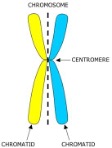
Identify chromosomes in a karyotype.
Karyotype – picture of chromosomes
22 single copies of pairs, 2 sex chromosomes
1. Describe the replication of DNA.
1. Starts with double helix – the ladder separates as hydrogen bonds break
2. Helicase unqinds and separates 2 DNA strands by breaking weak hydrogen bonds
3. Single strand binding proteins keep new DNA strands separated and unizzped
4. RNA primers present to start addition of new nucleoties – small amount of nucleotides provide a starting point
5. DNA polymerase can only synthesize in one direction, as strands are anti parallel – DNA can only be synthesized in a 5’ to 3’ direction, therefore we develop 3 strands, leading (5’->3’_ and lagging
6. DNA polymerase synthesizes in the 5’3’ direction on the leading strand from the point of origin towards the opening of the replication fork
7. Once it has synthesizes, starts synthesizes the lagging strand by adding small fragments of nucleotides called Okazaki fragments (3-4 bases) before backtracking and adding another using RNA primer. Ligase joins the Okazaki fragments together.
8. Then, DNA ligase glues everything together and makes sure correct bonds have reformed – 1 in 10,000 error rate by polymerase, but this is proof read by enzymes and the new rate is 1 in a billion.
The idea of base pairings is key as polymerase relies on it in order to match the correct base sequence
helicase
Helicase – enzyme that splits genes into single strands
primase
Primase – enzyme that synthesizes RNA primers
DNA polymerase
DNA polymerase - adds new nucleotides and grabs floating nucleotides to join to DNA, and proof reads
replication fork
Replication fork – single separated strand of DNA used for DNA replication
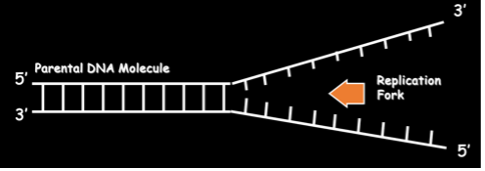
base sequence/gene sequence
order of bases in DNA
diagram of DNA replication
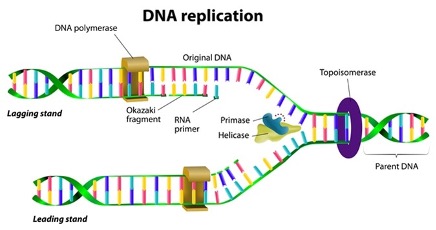
Discuss semi-conservative replication (Investigate other possible theories and the scientific evidence to support semi-conservative replication)
· Idea presented by Watson & Crick
· The two strands of the parental molecule separate, and each acts as a template for a new complementary strand
· New DNA consists of 1 PARENTAL (original) and 1 NEW strand of DNA
· That’s why it is called semi-conservative – half of the DNA is conserved
· Conservative – exact replica created with parent molecule preserved
· Dispersive – split in small pieces and put together
· Heavier isotope
DNA that was heavier than usual was replicated, and the resulting molecules were half the weight of the original
Explain protein synthesis
DNA is transcribed into mRNA. mRNA passes into the cell and binds to a ribosome. tRNA joins with an amino acid and pairs up with its complementary mRNA during translation.
· DNA codes for proteins, which do everything
· Genetic code – sequence of bases made of sections called of genes, where each gene codes for one polypeptide
· All polypeptides are made of chains of amino acids with fold into proteins
· Genes are universal – same sequence codes for the same amino acid in all organisms
· Transcription – production of mRNA from DNA template in the nucleus
· 1. RNA polymerase unwinds double stranded DNA
· 2. RNA polymerase adds nucleotides
· 3. Promotes transcription
· DNA base triples are transcriebed into mRNA codons
· Genetic code is non-overlapping, which means that base can only be in one codon at once
· Once mRNA is transcribed, it leaves the nucleus via a nuclear pore, where in the cytoplasm it combines with a ribosome
· Translation – mRNA -> polypeptide in ribosome
· Transfer RNA (tRNA) transfers amino acids to ribosome, and each tRNA corresponds to one amino acid and has a sequence of 3 bases called an anti-codon. The anti codon matches codons in the mRNA, and brings a specific amino acid based on the code.
· Translation always starts with a start codon, typically methionine
· Continues until all codons have been translated and polypeptide chain is complete, and a stop codon is reached
Amino acids bond using peptide bonds, and the polypeptide chain is released to be folded into a protein.
ribosome
Ribosome – a cellular structure on which the polypeptide chain will be built during translation
mRNA
· mRNA is a nucleic acid like DNA, except it’s:
· 1. Single stranded
· 2. Made of ribose sugar
· 3. Uracil instead of thymine
triplet
· A sequence of 3 bases is the code for a particular amino acid, called a triplet.
9. Analyse why the cell needs to divide.
10. Discuss the importance of mitosis, i.e. asexual reproduction, growth and replacement of cells (repair).
Cells are constantly dying – renewal
Injury
Growth
In order for us to exist as multi-cellular organisms
Describe the structure of chromosomes.
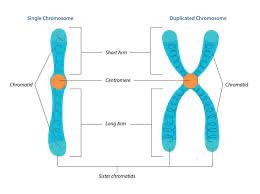
interphase
Interphase
- G1 phase – mature and grow
- Sometimes G0 – break (after this, can go into S phase or die)
- S phase – synthesis, DNA replication,
- G2 – preparation for mitosis occurs, checking that the cell is ready
prophase
Prophase
- DNA condenses and becomes chromosome
- Centrioles which have divided, form asters and move apart, until they are at opposite poles
- The nuclear membrane begins to disintegrate, eventually disappears
metaphase
Metaphase
- The doubled chromosomes line up along the equator of the cell with the spindle fibres attached to their centromeres
anaphase
Anaphase
- The chromosomes split and the chromatids are moved by the spindle fibres to each of the poles of the cell, and the cell membrane begins to pinch at the centre
telophase
Telophase
- Cell membrane completes constriction
- Nuclear membrane forms around chromosomes, which unravel
- Cytokinesis
diagram of mitosis
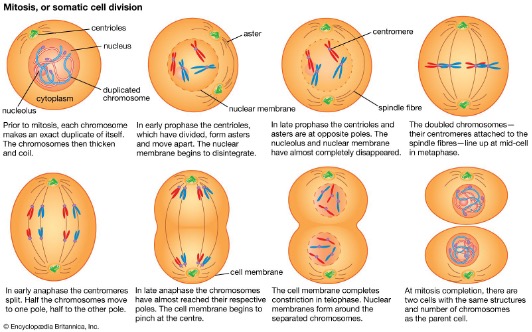
Clarify what is meant by haploid and diploid with reference to chromosomes.
Haploid – 23 chromosomes – one set of chromsomes
Diploid – 46 chromosomes – two sets of chromosomes
Describe cellular and chromosomal events that occur during the eukaryotic cell cycle and gamete formation
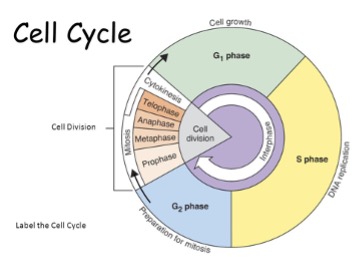
9. Study micrographs of different stages of meiosis and identify each stage |
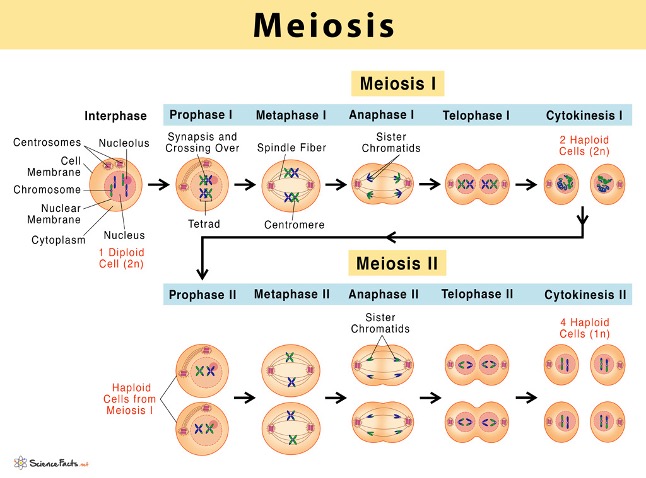
Describe chromosome movement, pairing and splitting as a cell progresses through meiosis I and meiosis II
1. Start off with a diploid cell – 23 pairs of 2 chromosomes.
Prophase I: DNA condenses into chromosomes. Each chromosome has been duplicated and remains closely associated. These are called sister chromatids.
Metaphase I: Chromosomes align at the centre of the cell.
Anaphase I: Chromosome pairs separate with sister chromatids remaining together.
Telophase I: Two daughter cells are formed with each daughter containing only one chromosome of the chromosome pair.
Two daughter cells are haploid – 23 chromosomes (each with two chromatids).
7. Prophase II: DNA condenses into chromosomes.
8. Metaphase II: Chromosomes line up at the centre of the cell.
9. Anaphase II: Centromeres divide and sister chromatids move separately to each pole.
10. Telophase II: Each cell splits in two to produce two daughter cells.
Explain how meiosis and random fertilisation contribute to genetic variation in sexually reproducing organisms.
· Because the result of meiosis is four different daughter cells, it means that all of an individual’s sex cells (gametes) are different and genetically unique, and because of crossing over, the chromosomes themselves have different contents.
· When reproducing, each one of the organisms contribute one unique cell, and that cell is also chosen randomly – this is called random fertilization
· Furthermore, because chromosomes are randomly split into daughter cells, there is also genetic diversity as each cell has a different version of the same chromosome – this is called independent assortment
Overall, this means that there are large amounts of genetic diversity in sexually reproducing organisms, as each offspring is unique
contrast meiosis and mitosis
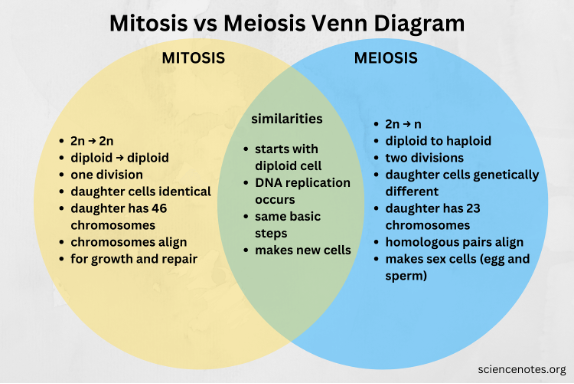
Describe the work of Mendel.
· He experimented with thousands of pea plants and established the basic foundations of inheritance, such as dominant and recessive characteristics.
· Mendel had no knowledge of DNA or genes but he did identify that inheritance is particulate, i.e. it depends on the transfer of separate (discrete) factors from parents to offspring
· The type of experiment that Mendel carried out, investigating just a single characteristic, is called a monohybrid cross
He then used his findings to propose 2 laws
Explain Mendel’s laws of inheritance
1. Law of segregation
· Alternate versions of factors cause variation in inherited characteristics.
· An organism inherits two factors for each characteristic – one from each parent.
· Dominant factors will always mask recessive factors.
· The two factors for each characteristic separate during gamete production.
2. Law of independent assortment
· Factors for different characteristics are sorted independently during gamete production.
Recognise the work of Reginald C Punnett in helping us make genetic predictions.
· Discovered genetic linkage
· Studied fundamental processes of Mendelian genetics, including linkage, sex determination, sex linkage, and autosomal linkage
Punnett squares are named after him, as he devised them
acquired
acquired – A characteristic of an organism that depends on environmental factors.
allele
allele – One version of a gene, found at a specific location along a chromosome
carrier
carrier – An individual with a recessive allele, whose effect is masked by a dominant allele.
characteristic
characteristic – A specific feature of an organism, such as eye colour.
co dominance
co-dominance – A situation where two alleles are equally dominant.
dominant
dominant – An allele that is always expressed, even if the cell only contains one copy.
genotype
genotype – alleles or variants an individual carries in a particular gene or genetic location.
heterozygous
heterozygous – Having two different alleles of a specific gene.
homologous chromosomes
homologous chromosomes – A matched pair of chromosomes that carry genes for the same characteristics.
homozygous
homozygous – Having two identical alleles of a specific gene.
incomplete dominance
incomplete dominance – A situation where two alleles are both partially expressed, producing an intermediate phenotype.
inherited
inherited – A characteristic of an organism that depends on its genes.
monohybrid cross
monohybrid cross – A cross in which one pair of characteristics is studied.
phenotype
phenotype – All the observable characteristics of an organism.
recessive
recessive – An allele that is only expressed if two versions of it are present in a cell.
chromosome
Thread-like structures made of DNA and proteins found in the nucleus of cells. They carry genetic information and are crucial for cell division and inheritance.
sex-linked
"Sex-linked" refers to genes located on the sex chromosomes. In humans, sex-linked traits are more commonly expressed in males due to the presence of only one X chromosome.
autosomal
Refers to any chromosome that is not a sex chromosome, carrying genes that determine non-sex characteristics.
pedigree
A diagram that shows the genetic relationships among a group of individuals, typically used to track the inheritance of a specific trait or disease within a family.
hybrid
- Offspring resulting from the crossbreeding of two genetically different individuals or species, often possessing a mix of traits from both parents.
locus genes
specific position of a gene on a chromosome
karyotype
A visual display of an individual's chromosomes arranged in a systematic manner to analyze chromosomal number, size, and structure.
gene
A unit of heredity that is passed from parent to offspring and determines some of the characteristics of the offspring.
mutation
A permanent change in the DNA sequence of an organism, which can result from errors during DNA replication, exposure to mutagens, or genetic recombination.
zygote
Zygote: Fertilized egg formed by the union of sperm and egg during fertilization. It contains the full set of chromosomes and is the earliest stage of embryo development.
fertilisation
Fertilisation is the process where a sperm cell fuses with an egg cell to form a zygote, initiating the development of a new organism.
sperm
Male reproductive cell with a single set of chromosomes, produced in the testes and used in fertilization.
ova
Ova are female reproductive cells produced by the ovaries, containing genetic material and capable of being fertilized by sperm to create offspring.
diploid
Cells with two sets of chromosomes, one from each parent, denoted as 2n. Found in most human cells, except gametes.
haploid
A cell containing only one set of chromosomes, half the number found in diploid cells. Common in gametes for sexual reproduction.
Codominance
phenomenon in which two alleles (different versions of the same gene) are expressed to an equal degree within an organism when they are both present
incomplete dominance
phenomenon in which two dominant alleles, if present, express to create a hybrid phenotype which is an intermediate mix of the two dominant alleles
Polygenic inheritance
inheritance of a trait governed by more than one gene, ie the genes coding for this trait are found in various parts of the genome, harder to predict
sex linked inheritance
· Genes are located on the sex chromosomes are described as sex linked
· Carried on the x chromosome
· This means that males are more likely to be affected by x linked diseases as they only have one copy of the X chromosome
· Can be recessive or dominant
· Carrier – female who has a copy of the allele but isn’t affected
Sufferer – someone who is affected by the disease/has the characteristic
modes of inheritance
autosomal dominant, autosomal recessive, X-linked dominant, X-linked recessive
steps for predicting mode of inheritance
Steps:
1. Recessive or dominant?
2. If recessive, can x-linked recessive be rejected?
If dominant, can x-linked dominant be rejected?
patterns to consider
1. If both parents are affected and offspring is unaffected, allele must be dominant
2. If both parents are unaffected and offspring is affected, allele must be dominant
3. an allele cannot be X linked dominant if an affected father has a normal daughter
4. The allele cannot be X-linked dominant if a mother without the trait has a son with the trait (a song must inherit an X from his mother and if he inherits a dominant X linked allele, his mother must also show the effect)
5. If 3 and 4 are not in the pedigree, it could be x linked dominant
6. If a mother affected by the trait has a normal son it cannot be recessive x-linked (as mother would need two recessive, therefore son would receive recessive and would be affected)
7. If a daughter who is affected has a normal father (daughter must have two recessive, therefore one from father, but then father would be affected) is not recessive x-linked
8. If recessive allele, it is x-linked if males are affected more than females
Paley’s work
· Paley argued that the complexity of the universe is proof that there is a creator (religion), and that this could be seen through the suitability of organism’s functions to their environment, proposing the idea of adaptation
Lamarck’s work
· Lamarck’s theory – also a theory of evolution, different to Darwin’s
· -> variations occur due to changes in the environment
· -> all variations are passed onto the next generation
· -> the use or disuse of organs brings on the disuse/development of those organs in lifetime of organism
· -> does not consider struggle for existence
Darwin’s work
· Darwin’s theory of evolution
· -> variations occur naturally
· -> only useful variations are passed onto the next generation
· -> changes in organs occur due to the appearance of variations in a particular direction
· -> discusses struggle for existence
· Species change over time, new species come from pre-existing species, and all species share a common ancestor
· Species of organisms arise and develop through the natural selection of small inherited variations that increase the individual’s abilityto compete, survive, and reproduce
Wallace’s work
hypothesised that species evolve by adapting to their environment and collaborated with Darwin on the theory of evolution
fact
a fact is an observation that's been confirmed so many times that scientists can, for all intents and purposes, accept it as true
hypothesis
A hypothesis is a tentative explanation about an observation that can be tested. It's just a starting point for further investigation
law
a law is a detailed description of how some aspect of the natural world behaves
theory
A theory is an explanation of some aspect of the natural world that's well-substantiated by facts, tested hypotheses, and laws
observation
Observation – an act or instance of noticing or perceiving and the acquisition of information from a primary source
inference
Inference – an idea or conclusion that’s drawn from evidence and reasoning
how was Darwin’s theory treated initially?
- Critiqued a lot because religion was widespread, and it was considered that God was the reason for the design of organisms and not evolution
why is Darwin’s theory more compelling than Lamarck’s?
Compelling because more evidence, genetic variation accounted for, and for single celled organisms (become more complex = not true)
evolution
Change in the heritable characteristics of biological populations over successive generations
the 4 mechanisms of evolution
mutation, natural selection, genetic drift, gene flow
genetic drift
1. (random) Genetic drift
Completely random events that impact the gene pool, the smaller the population the more prominent the effect
Founder effect – a small group decides to migrate away from the original population and form own population that doesn’t represent the exact proportions of the original population leading to bias
gene flow
1. Gene flow - the transfer of genetic material from one population to another/flow of alleles between populations
Eg due to migration or leaving a population – can lead to biases towards certain alleles if they are more frequent in population, eg genetic variation and genetic disease
modes of selection
Directional – very strong genotype is favoured, eg tall or sohrt
Stabilizing – favours middle genotype, eg weight
Disruptive – both ends of spectrum favoured
Sexual – depending on struggle of finding partner
Artificial – based on human decisions
gene pool
Gene pool – sum of all alleles in a population
Changes between generations based on what is passed on
point mutation
- Point mutation – occur during DNA replication
- -> Deletion, substitution, addition of nucleotide